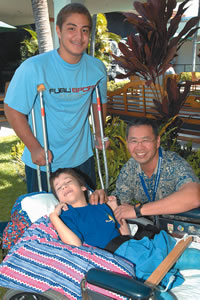Helping Hands And Open Arms
Interviewed by Melissa Moniz
Wednesday - May 14, 2008
E-mail this story | Print this page | Comments (0) | Archive
 Del.icio.us Share
Del.icio.us Share

Dr. Craig Ono
Pediatric Orthopedic Surgeon
How long have you been at Shriners Hospital?
I have been associated with Shriners since I’ve been a resident in training, and that was back in 1990. But I’ve been back as a full-time pediatric orthopedic surgeon since 2000.
How are the children selected to receive treatment at Shriners?
The children come in different ways. Some are referred from other physicians, some are self-referred. We’re a pediatric sub-specialty hospital, which means that we take care of children with pediatric orthopedic conditions. We also have a population of children who have burns and other patients who require plastic surgery type of procedures. They are selected based upon their need for treatment, and they are not selected based upon their financial needs. We’re a phil-anthropic organization, but we do not base our decisions on the ability to pay.

|
What is an average workday like for you?
How about I talk about what a week would be like for me, because I do something different every day. I see clinic two days a week, where I take care of children in the outpatient clinic, new patients and patients coming in for their pre-operative evaluations. Two days a week I operate and we do surgical procedures. Then one day a week, because I’m the assistant chief of staff and the medical director for telemedicine outreach services, that’s my administrative time to catch up on meeting and those responsibilities. We are all on the faculty and staff at the University of Hawaii, so we teach medical students. Like this morning, we had a conference with our University of Hawaii resident talking about genetics in orthopedics. So we have teaching responsibilities, and there’s also another day of the week where we sit down and review journal articles. We do a lot of academics here.
What are some of the most common orthopedic problems you see?
We do a lot of reconstructive surgeries, so those are surgeries on patients who have deformities due to old fractures, infections. We see particularly here in Hawaii a lot of patients who have club foot deformities. We take care of children who have cerebral palsy. We take care of children who have spina bifida. Today in the clinic we have a number of children who have scoliosis. We take care of children who have sports injuries. So it’s a very broad range of problems that we see here.
What are the most challenging surgeries to perform? The most challenging ones are the ones where we are asked to do surgery on children who are medically fragile and have many other medical issues.
They are the most challenging in respect to caring for them before, during and after the surgery. Some of the surgeries where we are doing major limb reconstruction, such as lengthening procedures, they are challenging in a different respect. They are challenging in getting the limbs to grow and just following along to get where we need to. They are challenging, but it’s a joy to take care of the children.
What are the biggest differences working with children rather than adults?
Kids are more fun, and after you take care of them, no matter what you do, they will always smile and give you a hug. The problems are different because kids grow. So in some respect, what you do today to a child who is 2 years old may be different when a child is 15 years old. So you have to anticipate the effects of growth and the fact that they change an awful lot as time goes on. That’s why we follow the children. Even when we go to the remote islands, we still make sure that we have a presence there so we can follow the children along.
When the new Shriners facility is built in 2010, is that going to change the number of children you see and the dynamics of your job?
We’re going to have so much more room. The whole idea is that the workload does increase. Hopefully we’ll have some additional capabilities. We will have a therapy pool so we can do water therapy. The hope is to get a Motion Analysis Laboratory, which we can use to analyze how the children move, which will help us in our decision-making in regard to outcome. I think the living environment should be better for us in terms of how the children are housed. It will certainly be a lot better as far as families being cared for because there will be a family quarters on site, which is very important for those whom we bring from far away.
E-mail this story | Print this page | Comments (0) | Archive
Most Recent Comment(s):













